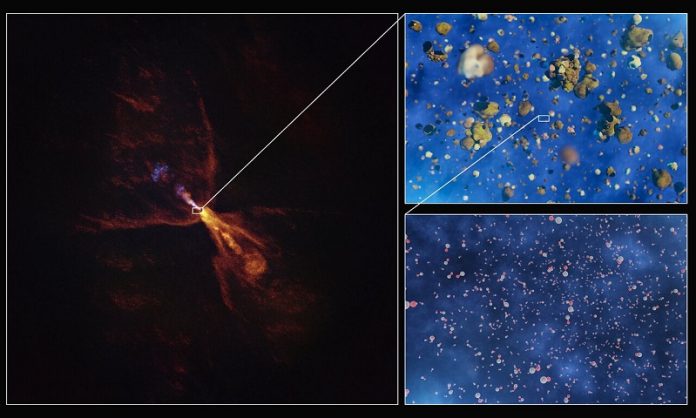
For the first time in history, scientists have caught a glimpse of a brand-new solar system just as it begins to form around a distant star.
Using two powerful telescopes — the James Webb Space Telescope (JWST) and the ALMA observatory in Chile — researchers spotted the very first solid particles that mark the beginning of planet formation.
This discovery provides a rare window into how our own Solar System may have looked over 4.5 billion years ago.
The new study, published in Nature, was led by Melissa McClure, a professor at Leiden University in the Netherlands.
She and her team focused on a young star called HOPS-315, located about 1,300 light-years from Earth. HOPS-315 is what’s known as a “protostar” — a baby star still surrounded by a swirling disc of gas and dust.
These discs, called protoplanetary discs, are the birthplaces of planets.
Scientists have previously seen young stars with massive planets already forming, but they had never observed the very beginning — the moment when dust begins to turn into solid building blocks of planets. That’s what makes this discovery so groundbreaking.
In our own Solar System, the earliest solid materials formed very close to the Sun and are now found in ancient meteorites that have crashed into Earth.
These meteorites contain high-temperature minerals, like crystalline silicon monoxide (SiO), which are thought to be some of the first materials to solidify as the Solar System was forming.
These small grains eventually clump together to form larger objects called planetesimals — the seeds of future planets.
In their new observations, the team detected these same minerals forming around HOPS-315. Using JWST, they found silicon monoxide gas and the early signs of its transformation into solid crystals.
Then, with ALMA, they pinpointed where exactly this was happening — in a region of the disc that matches the location of our own Solar System’s asteroid belt. It’s like looking at a snapshot of the Solar System’s earliest days.
According to co-author Merel van ‘t Hoff from Purdue University, this is like “seeing a baby picture of our Solar System.” The results suggest that HOPS-315 is following a very similar process to the one that led to Earth and the other planets.
This is the first time scientists have witnessed this key moment in planet formation outside our Solar System. It shows that the process may begin earlier than we thought and gives researchers a valuable case study for understanding how planets — and possibly life — can form elsewhere in the universe.
Elizabeth Humphreys, a European astronomer not involved in the research, praised the study, saying it shows how powerful JWST and ALMA are when used together. Thanks to this teamwork, astronomers now have a clearer picture of how solar systems begin — and new clues about where we came from.



